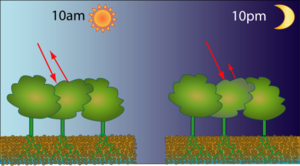Vegetation: A novel soil moisture sensor
In the next 5 years, NASA and ESA plan dedicated satellite missions to provide global observations of soil moisture, a crucial variable in hydrology, water resources, meteorology and climate science.
Two significant challenges persist in soil moisture estimation. Firstly, the planned instruments can only measure soil moisture in the top 0- 5cm, but we really need to know soil moisture in the root zone because it determines how much water is available to transpiring plants. Secondly, even surface soil moisture can only be measured if the overlying vegetation is sparse enough to allow microwaves through.
Rather than an obstacle to soil moisture retrieval, I propose treating vegetation as an additional source of information. Recent research (Friesen et al., 2009) demonstrated that the difference between the signal in the morning and evening passes of a radar satellite could be explained by plant water:
Water Unlimited

No difference in backscatter between AM and PM passes
Water Limited
Difference in backscatter between AM and PM passes
Plant water is controlled by how much water is available to the roots, so there should be a strong correlation between this time-lapse data (i.e measurements of the difference in backscatter between two satellite overpasses) and the root zone soil moisture. State-of-the-art soil moisture estimation typically uses data assimilation techniques to optimally merge uncertain satellite observations of the surface with imperfect hydrology models. Developing an approach to include this new type of data poses several significant challenges, which will be addressed in this study. A resistance capacitance model will be developed to simulate plant water as a function of root zone soil moisture for the major vegetation types. Lab experiments will investigate the relationship between the dielectric properties of vegetation and water stress (i.e. moisture availability in the root zone). A new technique developed in oil-reservoir modelling will be adapted and applied here to assimilate time-lapse data.
Are you interested in finding out more about this project, or working on part of it as a BSc. or MSc. project? Contact: Dr. Ir. Susan Steele-Dunne